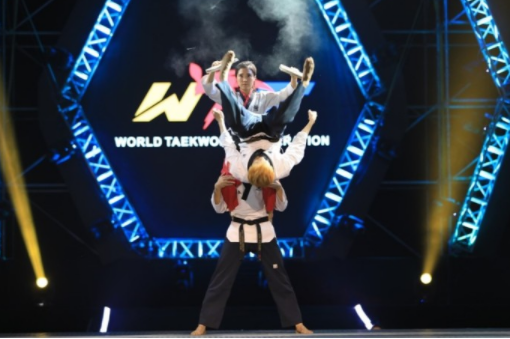Exploring the Training Program for the Essential Skills of TAEKWONDO Freestyle Poomsae
Sport
Views. 2040
Abstract
Purpose: The purpose of this study is to explore essential technical training plans for Taekwondo freestyle Poomsae and present systematic and specialized training plans to instructors. In order to achieve this research purpose, this study was conducted using a qualitative approach.Method: The purpose of this study is to explore essential technical training plans for Taekwondo freestyle Poomsae and present systematic and specialized training plans to instructors. In order to achieve this research purpose, this study was conducted using a qualitative approach of literature review and in-depth interviews.
Results: First, 1)jump side kick(Leap training using high speed, obstacle crossing training, and repetitive exercise to raise one's leaping foot to the thigh) 2)jump front kick(Training of kicking the first foot at the same time of the leap, the snap kick training in a sitting position, and the training to hit a target) 3)rotating kick(Stride training, holding the axis of rotation training, two-way rotation training) 4)consecutive sparring kick(Step training using a jump rope, repeating knee raising training, and various tactical training in actual sparring competitions) 5)acrobatic movements(Handstand training and training for using the strength of the upper body with push-ups). Second, as training for injury prevention, leap, and landing, strength exercises(squats, conventional deadlift, leg press) to improve posture balance and irregular physical training that changes heart rate to check the heart rate of actual competition situations are to be conducted. Third, efforts should be made to create a stable training environment for freestyle Poomsae training by providing equipment and tools such as air mats and landing mats for the athletes to stably train essential skills of freestyle Poomsae.
Conclusion: For each of the five essential skills of Taekwondo freestyle Poomsae, an efficient training method suitable for the characteristics of the skill is needed. In addition, players and instructors who train freestyle Poomsae need to improve their posture balance through training on high leaps and landing to prevent injuries. In addition, it is important to create a training environment suitable for the characteristics of the event for efficient training of freestyle Poomsae athletes.
[Keywords] Taekwondo, Freestyle Poomsae, Essential Skills, Training Program, Poomsae Players
References
[2] Lee SJ & Jeon JW. Recognition and Development Direction of Poomsae Competition by Players and Leaders in Accordance with the Introduction of Taekwondo Freestyle Poomsae. Taekwondo Journal of Kukkiwon, 8(4), 357-377 (2017).[5] Sihyun Ryu. Biomechanical Analysis of Spin Kicks for Establishing the Technical Difficulty of Free Style Poomsae in Taekwondo. International Journal of Martial Arts, 6(1), 66-76 (2021). [Article]
[7] Jeon MW & Lim SJ & Jeon IK. A Narrative Study on Poomsae Creation Experience of Taekwondo Instructo. The Journal of Korean Alliance of Martial Art, 15(1), 149-166 (2013).
[8] Jung HD. Strategies to Promote Free Style Poomsae Competition in Taekwondo. Journal of the World Society of Taekwondo Culture, 11, 55-67 (2015).
[9] Ahn JY. Exploration of Training Measures for Improving Freestyle Poomsae Performance in Taekwondo. Journal of Martial Arts, 13(3), 241-258 (2019).
[10] Yoo SH & Ryu JS & Park SK & Yoon SH. Successful Factor Analysis of 540o Dwihuryeochagi to Apply Free Style Poomsae of Taekwondo. Korean Journal of Sport Biomechanics, 23(4), 285-294 (2013).
[14] Lee SK & Ryu H. Analysis of Inductive Reasoning Process. Journal of Korea Society of Educational Studies in Mathematics, 14(1), 85-107 (2012).
[15] Heo YS & Jang K & Park JH. Effects of Lower Body Muscle Exercise over 8 Weeks on Performance of Free Poomsae Athletes. The Korea Free of Medcine & Therapy Science, 12(1), 63-73 (2020).
[17] Lee SJ & Jeoung JH. Comparative Analysis of Taekwondo Poomsae Professional Gym and High School Team Performance Factors. International Journal of Martial Arts, 6(1), 46-54 (2020). [Article]
[18] Kim JS & Cheon WK & Park JS. Exploring the Motives of College Taekwondo Poomsae Athletes for Participating in the Poomsae Competitions. International Journal of Martial Arts, 5(1), 1-13 (2020). [Article]
[19] Lee SJ & Kim JS & Park JS. The Effect of Self-management of Juvenile Taekwondo Breaking Athletes on Sports Competitive Anxiety. Kinesiology, 6(1), 1-9 (2021). [Article]
[20] Jang DE & Ahn YK. Aesthetical Exploration on Acrobatic Techniques in Taekwondo Demonstration. The Korean Journal of Physical Education, 56(1), 25-42 (2017).
[21] Park JS. The Effect of Functional Training on the Physical Strength Factor of Elite Taekwondo Athletes. Kinesiology, 4(1), 1-7 (2019). [Article]
[22] Park SU. Analysis and Research on Occurrence of Safety Accident in Taekwondo Training Center in Korea. International Journal of Sport,
1(2), 6-9 (2016). [Article]
[1] Jang K. A Study on the History of Korean Taekwondo Game. Woosuk University, Doctoral Thesis (2010).
[3] Cho SY. An Exploration of Training Method for Improvement of Athletic Performance of Taekwondo Free-poomsae Players. Yongin University, Master’s Thesis (2020).
[6] Kim DY. A Study on the Problems of Taekwondo Freestyle Poomsae Game. Chosun University, Master’s Thesis (2019).
[16] Shin HC. Comparison of Kinetic Characteristics of Taekwondo Jumping Front kick(Run up, Take Off and Kicking) according to Skill Levels. Korea University, Doctoral Thesis (2016).
[11] Kang SJ. Physical Education Research Methods. History of Education in the 21st Century (1994).
[12] Yoo JA. How to Write a Qualitative Research Thesis in Physical Education. Rainbow Temple (2004).
[13] Kim YC. Qualitative Research MethodologyⅠ. Methods. Academy (2013).
[4] http://www.koreataekwondo.org/ (2021).

?Source: worldtaekwondo.org
